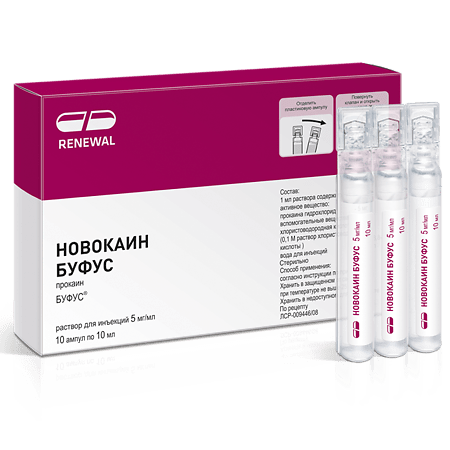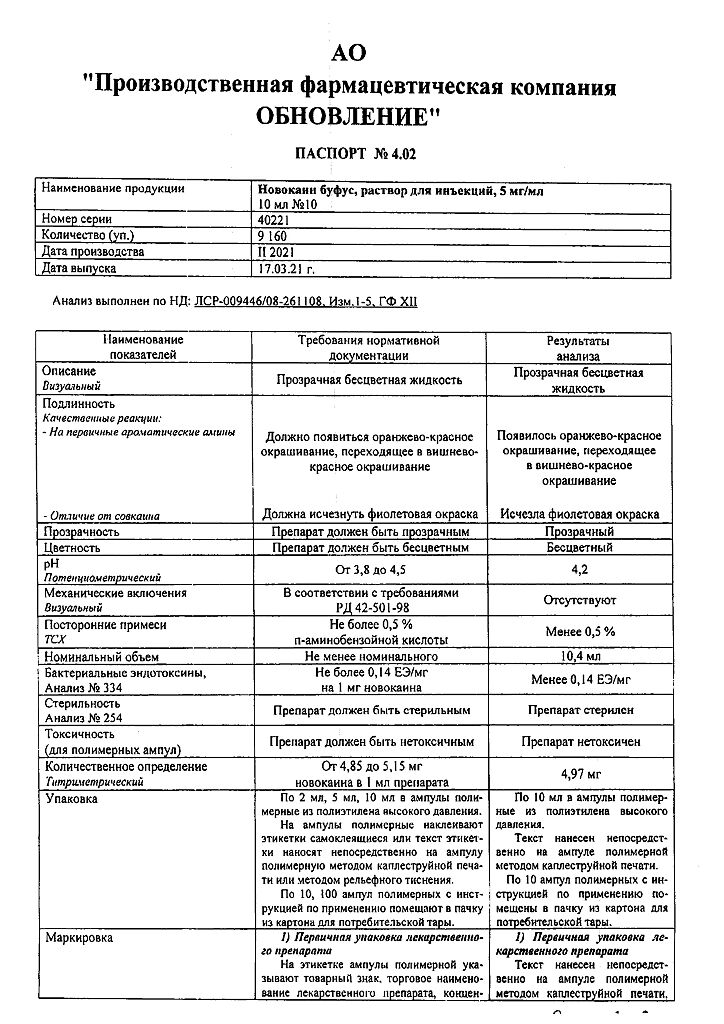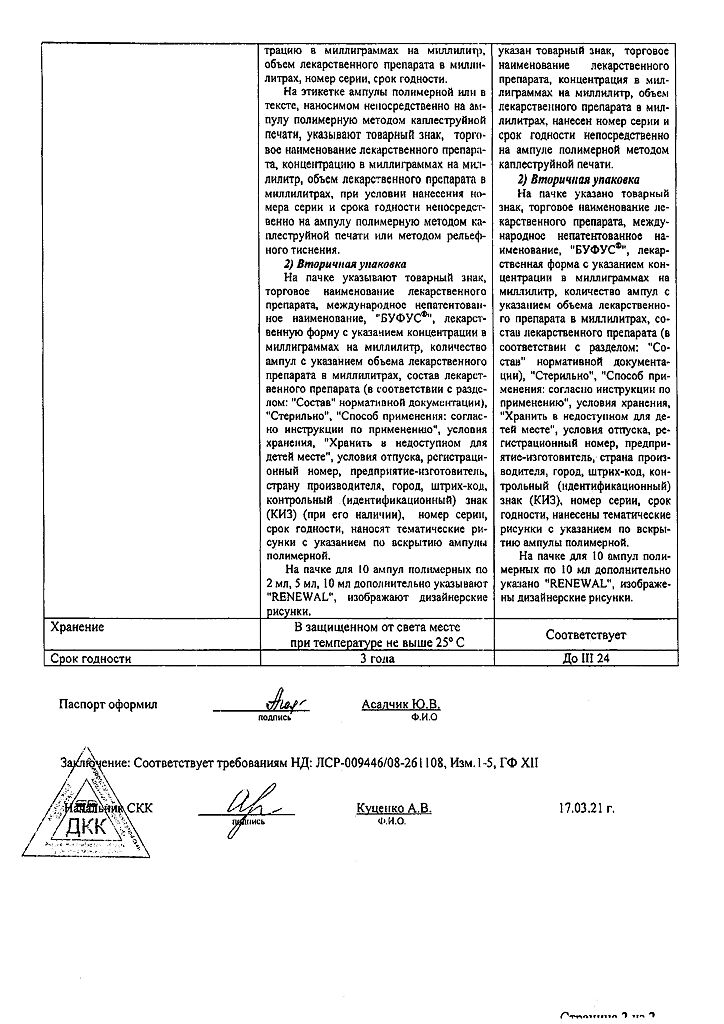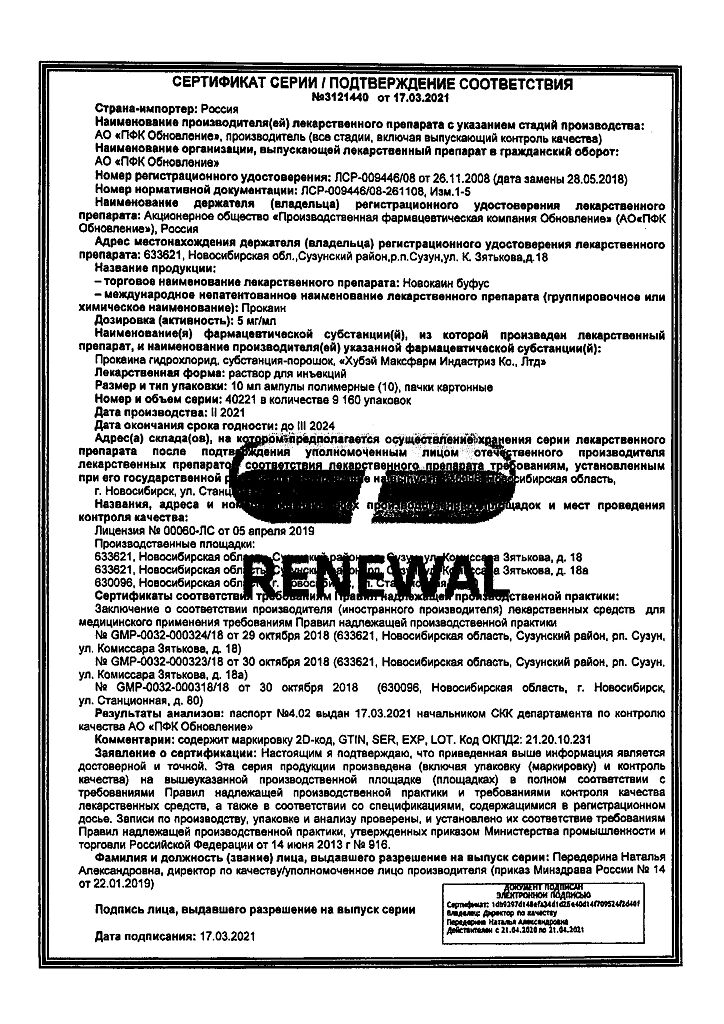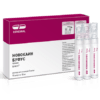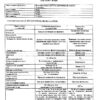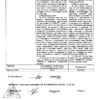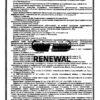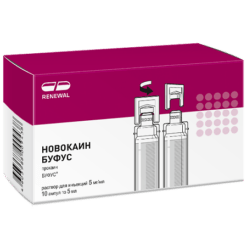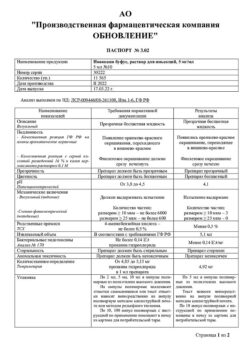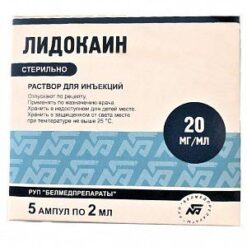No products in the cart.
Novocaine bufus, 5 mg/ml 10 pcs 10 pcs
€3.83 €3.19
EAN: 4603988009445
SKU: 228185
Categories: Anesthesia and resuscitation, Anesthesia solutions, Medicine
Description
A local anesthetic with moderate anesthetic activity and a wide range of therapeutic action. Being a weak base, it blocks Na+-channels, prevents generation of impulses in the endings of sensitive nerves and conduction of impulses along the nerve fibers.
Changes the action potential in nerve cell membranes without a pronounced effect on resting potential. It suppresses not only pain impulses but also impulses of other modality.
By absorption and direct vascular injection into the blood stream it decreases the excitability of peripheral cholinergic systems, reduces the formation and release of acetylcholine from preganglionic terminations (has some ganglion blocking effect), eliminates spasm of smooth muscles, reduces myocardial and cerebral motor areas excitability.
When administered intravenously it has analgesic, hypotensive and antiarrhythmic effect (increases the effective refractory period, decreases excitability, automaticity and conduction). Eliminates descending inhibitory effects of reticular formation of the brainstem. Inhibits polysynaptic reflexes. May cause convulsions in high doses. It has short anesthetic activity (duration of infiltration anesthesia is 0.5-1 hour).
Pharmacokinetics
Subject to complete systemic absorption. The degree of absorption depends on the place and route of administration (especially on vascularization and blood flow velocity in the area of administration) and the final dose (amount and concentration).
It is rapidly hydrolyzed by plasma and liver esterases to form 2 main pharmacologically active metabolites: diethylaminoethanol (has moderate vasodilator effect) and para-aminobenzoic acid (is a competitive antagonist of sulfonamide chemotherapeutic agents and can weaken their antimicrobial action). The elimination half-life is 30-50 seconds, in the neonatal period – 54-114 seconds. It is excreted mainly by the kidneys in the form of metabolites, not more than 2% is excreted unchanged.
Indications
Indications
Infiltration anesthesia;
vagosympathetic cervical, perinephric, circular and paravertebral blockades.
Pharmacological effect
Pharmacological effect
A local anesthetic with moderate anesthetic activity and a wide range of therapeutic effects. Being a weak base, it blocks Na+ channels, preventing the generation of impulses in the endings of sensory nerves and the conduction of impulses along nerve fibers.
Changes the action potential in the membranes of nerve cells without a pronounced effect on the resting potential. Suppresses the conduction of not only pain, but also impulses of other modalities.
When absorbed and directly vascularly introduced into the bloodstream, it reduces the excitability of peripheral cholinergic systems, reduces the formation and release of acetylcholine from preganglionic endings (has some ganglion-blocking effect), eliminates spasm of smooth muscles, reduces the excitability of the myocardium and motor zones of the cerebral cortex.
When administered intravenously, it has an analgesic, hypotensive and antiarrhythmic effect (increases the effective refractory period, reduces excitability, automaticity and conductivity); in large doses it can disrupt neuromuscular conduction. Eliminates descending inhibitory influences of the reticular formation of the brain stem. Inhibits polysynaptic reflexes. In large doses, it can cause convulsions. It has a short anesthetic activity (the duration of infiltration anesthesia is 0.5-1 hour).
Pharmacokinetics
Subject to complete systemic absorption. The extent of absorption depends on the site and route of administration (especially vascularization and blood flow velocity in the area of administration) and the final dose (amount and concentration).
It is rapidly hydrolyzed by plasma and liver esterases to form 2 main pharmacologically active metabolites: diethylaminoethanol (has a moderate vasodilator effect) and para-aminobenzoic acid (is a competitive antagonist of sulfonamide chemotherapeutic drugs and can weaken their antimicrobial effect). The half-life is 30-50 seconds, in the neonatal period – 54-114 s. It is excreted primarily by the kidneys in the form of metabolites; no more than 2% is excreted unchanged.
Special instructions
Special instructions
Regional and local anesthesia should be carried out by experienced specialists in an appropriately equipped room with the availability of equipment and drugs necessary for cardiac monitoring and resuscitation, ready for immediate use.
Personnel performing anesthesia should be qualified and trained in anesthesia techniques and should be familiar with the diagnosis and treatment of systemic toxicities, adverse events and reactions, and other complications.
Patients require monitoring of the functions of the cardiovascular, respiratory and central nervous systems. It is necessary to discontinue MAO inhibitors 10 days before the administration of a local anesthetic. During the treatment period, it is necessary to refrain from driving vehicles and engaging in potentially hazardous activities that require increased concentration and speed of psychomotor reactions.
Before use, testing for individual sensitivity to the drug is mandatory. It must be taken into account that when performing local anesthesia using the same total dose, the toxicity of novocaine is higher, the more concentrated the solution is used. Not absorbed from mucous membranes; does not provide superficial anesthesia for cutaneous use.
Active ingredient
Active ingredient
Procaine
Composition
Composition
1 ml of solution contains:
active substance:
procaine hydrochloride – 5 mg,
excipients:
hydrochloric acid
(0.1 M hydrochloric acid solution) – to pH 3.8-4.5,
water for injection – up to 1 ml.
Pregnancy
Pregnancy
Contraindicated for children under 12 years of age.
During pregnancy and lactation, the drug should be used when the benefit to the mother outweighs the risk to the fetus or child.
Contraindications
Contraindications
Hypersensitivity (including to para-aminobenzoic acid and other local anesthetics), children under 12 years of age. Pronounced fibrous changes in tissues (for anesthesia using the creeping infiltration method).
With caution
Emergency operations accompanied by acute blood loss, conditions accompanied by decreased hepatic blood flow (for example, with CNS, liver diseases), progression of cardiovascular failure (usually due to the development of heart block and shock), inflammatory diseases or infected injection sites, pseudocholinesterase deficiency, renal failure, childhood (from 12 to 18 years), in elderly patients (over 65 years), debilitated patients, pregnancy, period childbirth.
Side Effects
Side Effects
Headache, dizziness, drowsiness, weakness, increase or decrease in blood pressure, collapse, peripheral vasodilation, bradycardia, arrhythmia, chest pain, trismus, tremor, visual and hearing impairment, nystagmus, persistent anesthesia, hypothermia, methemoglobinemia, allergic reactions (up to anaphylactic shock).
Interaction
Interaction
Strengthens the inhibitory effect on the central nervous system of general anesthesia, hypnotics and sedatives, narcotic analgesics and tranquilizers.
Anticoagulants (ardeparin, dalteparin, danaparoid, enoxaparin, heparin, warfarin) increase the risk of bleeding.
When treating the injection site of a local anesthetic with disinfectant solutions containing heavy metals, the risk of developing a local reaction in the form of pain and swelling increases.
Use with MAO inhibitors (furazolidone, procarbazine, selegiline) increases the risk of hypotension.
Strengthen and lengthen the effect of muscle relaxants.
When procaine is prescribed together with narcotic analgesics, an additive effect is noted, which is used during spinal and epidural anesthesia, and respiratory depression increases.
Vasoconstrictors (epinephrine, methoxamine, phenylephrine) prolong the local anesthetic effect.
Procaine reduces the antimyasthenic effect of drugs, especially when used in high doses, which requires additional correction of the treatment of myasthenia.
Cholinesterase inhibitors (antimyasthenic drugs, cyclophosphamide, demecarine, ecothiophate, thiotepa) reduce the metabolism of procaine.
The procaine metabolite (para-aminobenzoic acid) is a sulfonamide antagonist.
Overdose
Overdose
Symptoms: pallor of the skin and mucous membranes, dizziness, nausea, vomiting, “cold” sweat, increased breathing, tachycardia, decreased blood pressure to the point of collapse, apnea, methemoglobinemia. The effect on the central nervous system is manifested by a feeling of fear, hallucinations, convulsions, and motor agitation.
Treatment: maintaining adequate pulmonary ventilation, detoxification and symptomatic therapy.
Storage conditions
Storage conditions
In a place protected from light.
Shelf life
Shelf life
3 years
Manufacturer
Manufacturer
Update of PFC JSC, Russia
Additional information
| Shelf life | 3 years |
|---|---|
| Conditions of storage | In a place protected from light. |
| Manufacturer | Update PFC AO, Russia |
| Medication form | solution for injection |
| Brand | Update PFC AO |
Other forms…
Related products
Buy Novocaine bufus, 5 mg/ml 10 pcs 10 pcs with delivery to USA, UK, Europe and over 120 other countries.

